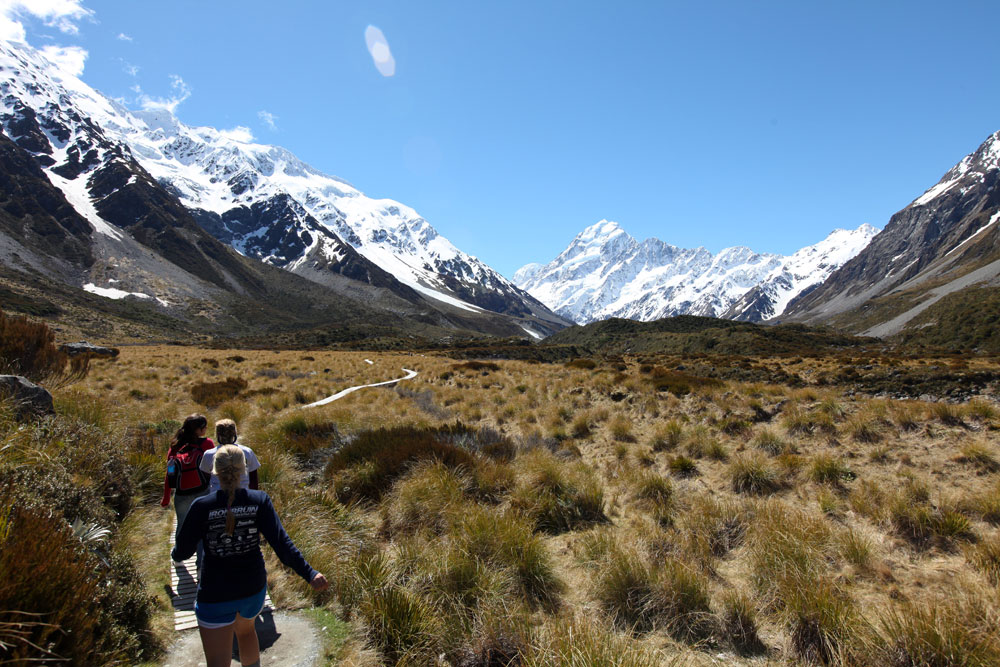Crafton Hills College Pre Reqs for Biola University Liberal Arts Major Major
Although American students studying away in New Zealand typically take a great academic feel, the feedback nosotros have received from working with thousands of students from the U.S. is that there are yet some surprising differences between the two systems that require an adjustment.
"I loved my academic feel, even with it being so different from what I'm used to." Shannon Meyer, College of Charleston, studied away at Victoria Academy of Wellington

College Instruction Structure
The higher education system in New Zealand is based on the UK system. A traditional business organisation or arts degree takes iii years of full-time study while engineering, education and other professional degrees can take four to half-dozen years.
A big difference from the U.S. is that students major very early on in their degrees, accept no full general education requirements and take very few electives. Information technology is considered that the tough last year of high school provides the full general education groundwork equivalent to the general education requirements in the U.Southward. college teaching system.
Due to the highly specialized degree structure, very few New Zealand students take courses outside of their field of study. Even so, U.S. written report abroad students attending New Zealand universities can take courses from across the different disciplines and usually do and so.
"I was fortunate where I had the luxury of taking some of my general electives while away and got to explore classes outside of my major." Brianna Siravo, Quinnipiac University, studied abroad at the University of Otago
Explore New Zealand Report Abroad Programs
Structure of courses (papers)
First of all, at some universities in New Zealand courses are called "papers". Most business and humanities courses accept two components: lecture and tutorial. A lecture can be quite big (sometimes 200 students in start-year lectures), is led by the professor teaching the class, covers the cloth for the week and is as it sounds – a lecture. Very little interaction happens during a lecture.
Tutorials are smaller groups (usually around xv to 25 students), support the content of the lecture and let for student word. Recollect of the tutorials equally a review session. While the tutorial tin be taken past the professor, they can sometimes also be led by teaching assistants (TAs) or grad students.
While attendance is rarely taken at the lecture, it is oft recorded in tutorials and a lack of omnipresence may affect your grade. Make certain you read the form outline (syllabus) provided in the starting time calendar week of classes to learn nearly the attendance and participation requirements.
The number of hours for lectures and tutorials tin vary between papers but typically at that place are two i-hour lectures and one one-hour tutorial per week. There is some variation on this. For example, Global Tourism at the University of Otago has three one-60 minutes lectures per week and no tutorial. T ypically all science courses, including psychology, have a laboratory component built into the newspaper. Science students volition therefore have more contact hours for the labs in improver to lectures.
"It was interesting to see the way courses were set up with both lectures and tutorials, which is not how it normally happens in my habitation university. The lectures had huge class sizes where new material was introduced. And tutorials were where nosotros were split into smaller groups and given assignments in gild to absorb the new cloth. I plant this to exist a very productive experience." Sharath Sreenivas, Indiana Academy, studied abroad at AUT University

Assessment and final exams
You should expect less assigned homework in New Zealand because your final grade is based on only a few assessments. Ordinarily there will be a newspaper due around mid semester and ane terminal examination assessing your knowledge from the entire semester that is unremarkably worth at least 50% of your final form. Science courses volition besides have lab reports as part of the assessment.
With none of the "busy work" typical of U.South. college courses, it can feel like y'all don't have to do equally much. However, if you lot don't keep up with readings that have been specified in your class outline each week, it'southward really piece of cake to fall behind. The reason your essay is due in Calendar week vii is because your professor expects you to accept been working on it for seven weeks. There is an expectation in New Zealand that you lot should be spending a meaning amount of fourth dimension engaged in independent study outside of the classroom.
"I won't lie, the thought that up to 70-80% of your form can be decided based on your terminal exam can be quite intimidating at first, considering how different this was from my habitation school. However, I feel like this structure of the courses emphasizes good work ethic in that you lot have to continue up with class material throughout the semester, equally in that location are not many internal assignments that add together to your grade." Brianna Siravo, Quinnipiac University, University of Otago
Become to know your Professors
With possibly less contact hours and more of a focus on independent learning, some U.S. students initially take some concerns. Withal, Kiwi professors are very outgoing if yous demand help, are less formal than in the U.S. and ordinarily go by their outset names. Although role hours are non common, professors are quick to reply to emails and happy to brand a time to chat with you. We besides suggest that y'all make an effort to introduce yourself to your professor.
"Although each professor did not have role hours like they do at my dwelling house university, they were all willing to make time out of their decorated schedules to meet with me when I asked for a little extra help." Kristen Cardarelli, University of New Hampshire, studied away at Victoria University of Wellington
"I really enjoyed the NZ education construction. The casualness between professors and students was refreshing and I enjoyed the lecture/tutorial format." Nicholas Johnstone, College of Charleston, Victoria University of Wellington

* Pinnacle image explanation: "This was a work in progress picture of a landscape by street creative person Fluke in collaboration with studio artist Talia Carin on the Otago University campus. Not only a beautiful and brilliant piece but the mural is of a hongi which symbolizes the sharing of jiff with another. The image represents shared breath and noesis, equally well as the commitment of treating a company every bit 1 of your own in the Māori worldview." Tiffany Young, University of Hartford
Take whatsoever questions almost studying in New Zealand? Just ask us! Larn more than virtually our programs in New Zealand.
Source: https://www.educationabroadnetwork.org/blog/differences-studying-college-new-zealand-usa/
0 Response to "Crafton Hills College Pre Reqs for Biola University Liberal Arts Major Major"
Post a Comment